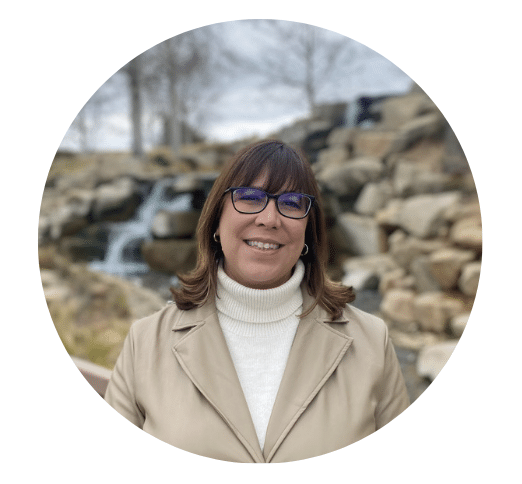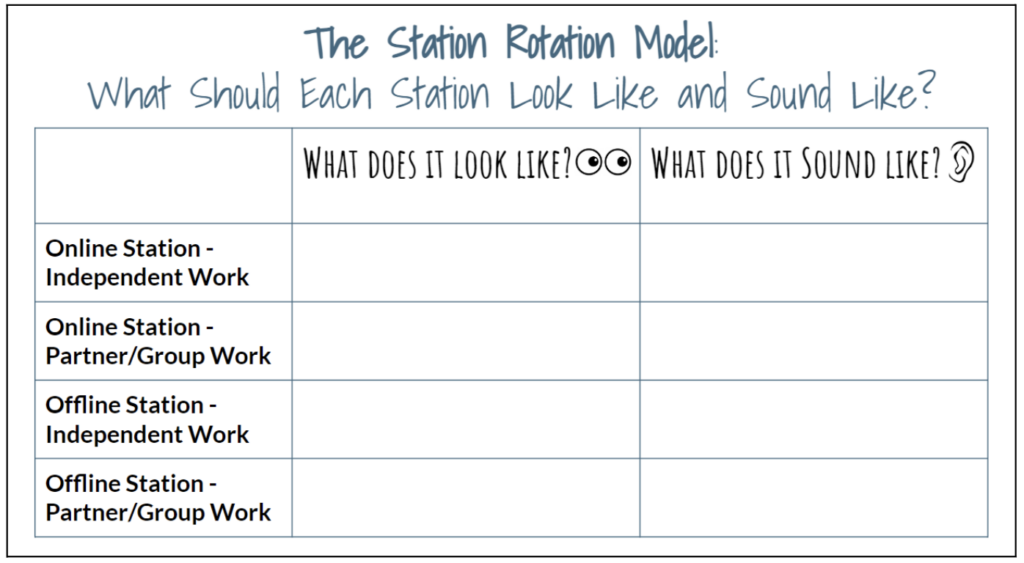
I was recently facilitating a training session on the station rotation model when several educators expressed concern about the noise level of the classroom during a station rotation lesson. They asked how I keep the noise level down at the stations that are not teacher-led. Like most classroom expectations, I spend time directly teaching what each type of station should look and sound like.
When introducing station rotation, I have students practice physically rotating from station to station. This helps students understand how to rotate to each station and what to do when they arrive at a new station. After they practice rotating a few times, I bring the class back together and explain that to get the most out of each station, I have certain expectations for what each station looks and sounds like.
I start by explaining that because I will be facilitating the teacher-led station, I need them to stay on task and use appropriate volume when speaking. I emphasize that the teacher-led station is my opportunity to work with small groups to ensure every student in the class is getting time with me, ensuring that everyone feels supported and makes progress. Once I’ve clearly articulated the value of my teacher-led station and why I need to be able to focus on the students at that station, I’ve found it helpful to engage students in the process of identifying what learning should look and sound like given the learning task.
What Does Each Station Look and Sound Like?
I used the following slide and had students work in pairs to discuss what they think each type of station should look and sound like and then jot down their ideas on a piece of paper. Depending on the age of the students, they can write down phrases and words, or draw simple sketches. I provide guiding questions for students who may need it, such as:
- What materials should be out on your desk?
- How should you be interacting with others at your station?
- How loud should your voices be at this station?
- What should you avoid doing at this station?
After students had a few minutes to discuss and write down what they believed each station should look like and sound like, I invited them to share their responses as I documented their ideas on the whiteboard. Once they shared their thinking, I presented my expectations. We compared their thoughts about the volume and types of interactions at each type of station to my expectations. When their responses were different from mine, we talked about why their description of the station was different from my own.
Below are some of the questions I used when facilitating this discussion about the differences between their answers and my thoughts about the stations.
- Can you share what influenced your expectations for this type of station?
- Were there any specific experiences that shaped your ideas about what learning looks or sounds like at this type of station?
- Do you think your personal learning preferences played a role in your expectations?
- How do the specific learning objectives for this station align with your expectations?
- Can we identify common elements in our ideas and merge them to create a more comprehensive set of station expectations?
Engaging students in the process of setting expectations for noise levels and interactions at a small group learning station before implementing the station rotation model has several significant benefits from increasing ownership and accountability while also creating clarity about what is expected of them. Involving students in this way can lead to a more successful and seamless implementation of the model. When students have a voice in shaping their learning environment, it is empowering and boosts their confidence in their ability to be successful. They also feel that their opinions are valued, leading to increased motivation and engagement.
Use Visual Aids to Reinforce Expectations
Once students have a clear and explicit understanding of the expectations for each type of station, I use visual aids to reinforce these norms. Specifically, I create and display posters for each type of station, which stay up throughout the year so we can easily reference or revisit expectations. These posters serve as constant reminders, illustrating both the desired appearance and ambiance of each station.
Regardless of whether you are working with young learners or older students, being clear about what is expected creates a foundation for mutual respect and understanding. By having these expectations visually presented, students can regularly self-check their behaviors and actions, leading to a more self-regulated learning environment.

Teaching classroom expectations isn’t merely a formality; it’s an essential step in classroom management and in setting up any instructional model, including the station rotation model. By taking the time to be explicit about these expectations and using visual reminders like posters, educators set the stage for a smooth, productive, and harmonious learning experience. This approach ensures that the station rotation model is not only introduced but is also sustained effectively throughout the academic year.
Additional Tips
- Review the expectations by referring to the posters in the room when needed. Students will need reminders throughout the year.
- To help keep the noise level down during a station rotation lesson, have at least one independent station. For example, if I have four stations, two of them may be collaborative, and the other two may be independent. This way, you have fewer students talking at any given time.
If you are interested in learning how to design and facilitate learning with the station rotation model, check out Dr. Tucker’s self-paced mini-course online or grab a copy of her book The Complete Guide to Blended Learning!




2 Responses
Perfect timing! I just did the first round of practice station rotation with my students this year. Overall it went well, but I did find the noise in the collaborative groups to be a bit louder than I would like – though they were definitely on task. This will help frame a follow-up lesson nicely. As always, it is so important to be explicit about expectations and involve students in the process.
Yay! I love it when that happens, Christina! So glad this was helpful.
Take care.
Catlin